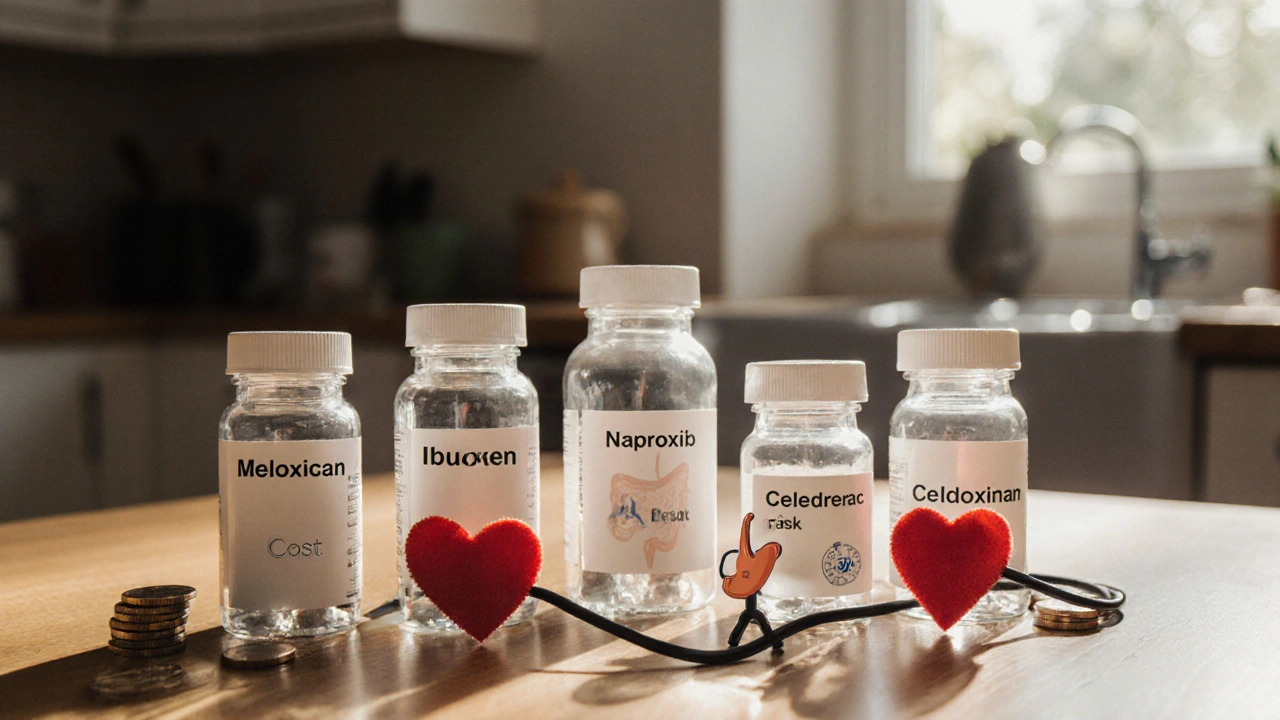NSAID Comparison Tool
Comparison Results
Quick Takeaways
- Mobic alternatives include ibuprofen, naproxen, celecoxib, diclofenac and aspirin.
- Meloxicam is a long‑acting NSAID best for chronic arthritis pain.
- GI‑related side effects are lower than many older NSAIDs but still present.
- Cardiovascular risk rises with COX‑2‑selective drugs like celecoxib.
- Cost varies: generic meloxicam is cheap, while celecoxib can be pricey without insurance.
What is Mobic (Meloxicam)?
When you see the name Meloxicam a prescription‑grade non‑steroidal anti‑inflammatory drug (NSAID) Mobic, it’s the same compound used to treat osteoarthritis, rheumatoid arthritis and acute musculoskeletal pain. It comes in 7.5mg and 15mg tablets, and the drug’s half‑life of about 20hours lets most patients take it once daily.

How does Meloxicam work?
Meloxicam blocks the cyclooxygenase‑2 (COX‑2) enzyme more strongly than COX‑1, which means it reduces prostaglandin production that causes inflammation and pain. Because COX‑1 helps protect the stomach lining, the COX‑2‑selectivity gives meloxicam a slightly better gastrointestinal (GI) safety profile than older NSAIDs that inhibit both enzymes equally.
Side effects and safety considerations
Even with its COX‑2 bias, meloxicam can still irritate the stomach, especially at higher doses or when taken with alcohol. Common side effects include mild nausea, headache and occasional dizziness. Serious risks involve:
- GI bleeding or ulcer formation - about 1‑2% of long‑term users.
- Increased blood pressure - particularly in patients with hypertension.
- Cardiovascular events - risk rises with doses above 15mg per day.
Renal impairment is a concern for anyone with existing kidney disease or who takes diuretics. Always discuss these issues with a clinician before starting or switching NSAIDs.
Key alternatives to Mobic
Below are five widely used NSAIDs that people often consider instead of meloxicam.
- Ibuprofen a short‑acting, non‑selective NSAID - typical dose 200‑400mg every 4‑6hours, over‑the‑counter (OTC) in many countries.
- Naproxen another non‑selective NSAID with a longer half‑life than ibuprofen - 250‑500mg twice daily for arthritis.
- Celecoxib a COX‑2‑selective prescription NSAID - 100‑200mg once daily, marketed as a “gut‑friendly” option.
- Diclofenac a potent non‑selective NSAID available as tablets, gel and patches - 50‑75mg two to three times daily.
- Aspirin an older NSAID that irreversibly inhibits COX‑1, also used for heart protection - low‑dose 81mg daily for cardiovascular benefit; higher doses (325‑650mg) for pain.

Side‑by‑side comparison
| Drug | Class | Typical Dose | Onset (hrs) | Duration (hrs) | GI Risk | Cardio Risk | Average Monthly Cost (US$) |
|---|---|---|---|---|---|---|---|
| Meloxicam | COX‑2‑preferring NSAID | 7.5mg or 15mg once daily | ≈1 | ≈24 | Low‑moderate | Moderate | ≈5 (generic) |
| Ibuprofen | Non‑selective NSAID | 200‑400mg q4‑6h | ≈0.5 | ≈6‑8 | High | Low | ≈2 (OTC) |
| Naproxen | Non‑selective NSAID | 250‑500mg bid | ≈1 | ≈12‑15 | Moderate‑high | Low‑moderate | ≈4 (OTC) |
| Celecoxib | COX‑2‑selective NSAID | 100‑200mg qd | ≈1 | ≈24 | Low | High | ≈30 (brand) / 10 (generic) |
| Diclofenac | Non‑selective NSAID | 50‑75mg tid | ≈0.5 | ≈6‑12 | High | High | ≈8 (generic) |
| Aspirin | Non‑selective NSAID (COX‑1 irreversible) | 81mg qd (cardio) / 325‑650mg q4‑6h (pain) | ≈0.5 | ≈4‑6 | High (at analgesic doses) | Low (low‑dose) / Variable (high‑dose) | ≈1 (OTC) |
How to pick the right NSAID for you
Choosing an NSAID isn’t one‑size‑fits‑all. Consider these factors before swapping Mobic for something else:
- Stomach tolerance: If you’ve had ulcers, a COX‑2‑selective option like meloxicam or celecoxib may feel safer.
- Heart health: Patients with hypertension, heart failure or a history of heart attack should avoid high‑cardio‑risk NSAIDs (celecoxib, diclofenac) unless a doctor says otherwise.
- Pain intensity and timing: For short‑term flare‑ups, fast‑acting ibuprofen or naproxen work well. For chronic, daily pain, meloxicam’s once‑a‑day dosing is convenient.
- Drug interactions: Take note of blood thinners, ACE inhibitors or diuretics. NSAIDs can blunt the effect of some antihypertensives.
- Cost and insurance coverage: Generic meloxicam and ibuprofen are usually cheap; celecoxib can be pricey without a prescription benefit.
Always discuss with a healthcare professional, especially if you have kidney disease, liver disease, or are pregnant.
Frequently Asked Questions
Can I switch from Mobic to ibuprofen without a doctor?
You can buy ibuprofen over the counter, but a doctor should review your medical history first. Switching may change how often you need to take a pill and could increase stomach irritation.
Is meloxicam safer for my stomach than naproxen?
Generally yes. Meloxicam’s stronger COX‑2 selectivity lowers the chance of gastric ulcers compared with non‑selective naproxen, though the risk isn’t zero.
What’s the biggest advantage of celecoxib over meloxicam?
Celecoxib is even more COX‑2 selective, so it can be gentler on the stomach for some users. It also comes in a liquid capsule for people who have trouble swallowing pills.
Will meloxicam affect my blood pressure?
Yes, like most NSAIDs it can raise blood pressure in a subset of patients, especially at higher doses. Monitoring is advised if you already have hypertension.
Are there any natural alternatives to Mobic?
Turmeric (curcumin), ginger and omega‑3 fatty acids have mild anti‑inflammatory effects, but they don’t match the potency of prescription NSAIDs for moderate‑to‑severe arthritis pain. Talk to a doctor before replacing meloxicam.

Drew Chislett
October 7, 2025 AT 15:47I’ve been on meloxicam for a few months and the once‑daily dosing really simplifies my routine. The GI side‑effects have been mild for me compared with occasional ibuprofen use. If you’re juggling multiple meds, fewer pills can reduce confusion. Keep an eye on blood pressure, especially if you have hypertension. Overall, it feels like a solid middle‑ground NSAID.
Rosalee Lance
October 9, 2025 AT 23:20When you read the table you might think the numbers tell the whole story, but the hidden agenda of pharmaceutical companies is rarely that simple. The narrative that COX‑2‑selective drugs are “gut‑friendly” is a marketing spin designed to keep us dependent on pricey brand names. In reality, the molecular pathways overlap enough that meloxicum still compromises the mucosal barrier in a subset of patients. Moreover, the cardiovascular risk profile is a moving target; the data behind the “moderate” label often excludes high‑risk populations. If you look at the raw trial data you’ll see a subtle uptick in thrombotic events that most summaries gloss over. This is why independent meta‑analyses are crucial, not just the glossy FDA labels. Another layer of secrecy lies in the way adverse event reporting is incentivized – doctors are paid to prescribe, and that bias bleeds into the literature. The cost comparison also hides the fact that insurance formularies can make a generic meloxicam cost seem negligible while charging a premium for celecoxib, steering patients toward one product over another. You should also consider drug‑drug interactions; meloxicam can amplify the nephrotoxic effects of ACE inhibitors, a fact that rarely makes the headlines. The “once‑daily” convenience is a double‑edged sword because missed doses can lead to a rebound in inflammation that feels worse than a regular NSAID schedule. If you’re prone to ulcers, combining a PPI with any NSAID – even a COX‑2‑preferring one – does not eliminate risk, it merely postpones it. The system also under‑reports over‑the‑counter ibuprofen usage, skewing comparative safety data. Think about the environmental impact too; non‑steroidal anti‑inflammatory drugs are persistent pollutants in waterways, and the most heavily prescribed drugs have the highest ecological footprints. Ultimately, the choice should be guided by a transparent risk‑benefit analysis, not by the glossy ads that dominate the internet. Stay skeptical, read the primary literature, and always discuss with a healthcare professional who isn’t financially tied to a specific brand.
Kara Lippa
October 12, 2025 AT 06:53Your point about hidden agendas is spot‑on. I always double‑check the primary sources before accepting safety claims. It’s a good reminder to stay critical.
Puneet Kumar
October 14, 2025 AT 14:27From a pharmacology perspective, meloxicam’s half‑life of about 20 hours aligns well with chronic arthritis management, reducing dosing frequency. However, the metabolism via CYP2C9 means genetic polymorphisms can affect plasma levels, potentially increasing toxicity in certain ethnic groups. In the Indian subcontinent, we see a higher prevalence of CYP2C9*3 alleles, which warrants dose adjustments. Also, the drug‑drug interaction with common antihypertensives can blunt their efficacy, a nuance often omitted in generic tables.
michael maynard
October 16, 2025 AT 22:00Nice details, but don’t forget the hidden surveillance networks tracking NSAID prescriptions.
Roger Bernat Escolà
October 19, 2025 AT 05:33Meloxicam feels like the Goldilocks of NSAIDs.
Allison Metzner
October 21, 2025 AT 13:07The elite‑only narrative around “gut‑friendly” NSAIDs is just a veneer for profit. While most of us can afford cheap ibuprofen, the industry pushes brand‑name celecoxib as the superior choice, banking on fear of ulcers. This stratification of care reinforces socioeconomic divides and keeps patients in a cycle of dependence on patented drugs. It’s a classic case of the pharmaceutical oligarchy dictating what’s “safe” while marginalizing generic alternatives.
william smith
October 23, 2025 AT 20:40That’s a solid take on the profit motives. A quick heads‑up: always check if your insurance covers the generic to avoid those extra costs.
Timothy Javins
October 26, 2025 AT 04:13I’m skeptical of any single drug being labeled “safe”. The data is often cherry‑picked.
Kay Yang
October 28, 2025 AT 11:47True, cherry‑picking is common. I try to look at the full spectrum of studies before deciding.
Rajesh Kumar Batham
October 30, 2025 AT 19:20Just a note: in some regions, meloxicam isn’t even on the formulary, so patients end up on ibuprofen by default.
Bill Gallagher
November 2, 2025 AT 02:53Interesting point about formularies; it’s a reminder that drug availability shapes prescribing habits. Also, the pharmacokinetics of ibuprofen-its rapid onset-make it attractive for acute flare‑ups. Yet, the short half‑life means more frequent dosing, which can affect compliance. Ultimately, clinicians balance these trade‑offs based on patient lifestyle and comorbidities.
Rajashree Varma
November 4, 2025 AT 10:27When it comes to choosing an NSAID, consider both the pharmacological profile and your personal health history. A patient with a history of ulcers might benefit from the COX‑2‑preferring nature of meloxicam, but they should still monitor for any GI discomfort. Conversely, someone with cardiovascular risk factors should be cautious with celecoxib due to its higher cardio‑risk rating. Remember that lifestyle factors-like alcohol consumption-can amplify GI risks across all NSAIDs. It’s always a good plan to discuss these nuances with a healthcare provider who can personalize the recommendation.
Anshuman Pandey
November 6, 2025 AT 18:00Your summary hits the key points. Personalizing therapy is essential.
Thomas Malloy
November 9, 2025 AT 01:33Short and sweet: always read the label.
Sushma Gowda
November 11, 2025 AT 09:07Agreed, the label often contains hidden warnings that are easy to miss.
Angie Wallace
November 13, 2025 AT 16:40Labels can be dense, so a quick chat with your pharmacist can clarify dosage and risks.
Doris Montgomery
November 16, 2025 AT 00:13Pharmacist advice is useful, but many still ignore it and self‑medicate.